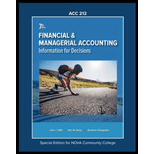
Concept explainers
Inventory: Inventory refers to the stock or goods which will be sold in the near future and thus is an asset for the company. It comprises of the raw materials which are yet to be processed, the stock which is still going through the process of production and it also includes completed products that are ready for sale. Thus inventory is the biggest and the important source of income and profit for the business.
First in first out: In case of First in, first out method, also known as FIFO method, the inventory which was bought first will also be the first one to be taken out.
Last in first out: In case of Last in, First out, also known as LIFO method, the inventory which was bought in the last will be taken out first.
Inventory turnover ratio: It depicts the fraction of inventory sold or used by the company within a fiscal year. It states a ratio which shows the number of times goods were sold during an accounting period which thereby states the productivity or the efficiency level of the company regarding the inventory which apparently is the biggest asset for the company.
Days’ sales in inventory: It indicates the days taken up by the company to convert the stock items into actual sales.
1.
To compute: Current ratio, inventory turnover and days’ sales in inventory for 2017 as per:
(a) LIFO numbers
(b) FIFO numbers
2.
To interpret: Results of part 1.
Want to see the full answer?
Check out a sample textbook solution
Chapter 5 Solutions
FIN & MANAGERIAL ACCT VOL 2 W/CONNECT
- What would be his recognize gain ?arrow_forwardLynn Inc has provided the following data from its activity-based systemarrow_forwardThe GNR Manufacturing Co. recorded overhead costs of $21,500 at an activity level of 5,000 machine hours and $8,000 at 2,500 machine hours. The records also indicated that overhead of $10,000 was incurred at 4,200 machine hours. Using the high-low method to estimate the cost equation, determine the variable cost per machine hour.arrow_forward

 AccountingAccountingISBN:9781337272094Author:WARREN, Carl S., Reeve, James M., Duchac, Jonathan E.Publisher:Cengage Learning,
AccountingAccountingISBN:9781337272094Author:WARREN, Carl S., Reeve, James M., Duchac, Jonathan E.Publisher:Cengage Learning, Accounting Information SystemsAccountingISBN:9781337619202Author:Hall, James A.Publisher:Cengage Learning,
Accounting Information SystemsAccountingISBN:9781337619202Author:Hall, James A.Publisher:Cengage Learning, Horngren's Cost Accounting: A Managerial Emphasis...AccountingISBN:9780134475585Author:Srikant M. Datar, Madhav V. RajanPublisher:PEARSON
Horngren's Cost Accounting: A Managerial Emphasis...AccountingISBN:9780134475585Author:Srikant M. Datar, Madhav V. RajanPublisher:PEARSON Intermediate AccountingAccountingISBN:9781259722660Author:J. David Spiceland, Mark W. Nelson, Wayne M ThomasPublisher:McGraw-Hill Education
Intermediate AccountingAccountingISBN:9781259722660Author:J. David Spiceland, Mark W. Nelson, Wayne M ThomasPublisher:McGraw-Hill Education Financial and Managerial AccountingAccountingISBN:9781259726705Author:John J Wild, Ken W. Shaw, Barbara Chiappetta Fundamental Accounting PrinciplesPublisher:McGraw-Hill Education
Financial and Managerial AccountingAccountingISBN:9781259726705Author:John J Wild, Ken W. Shaw, Barbara Chiappetta Fundamental Accounting PrinciplesPublisher:McGraw-Hill Education





